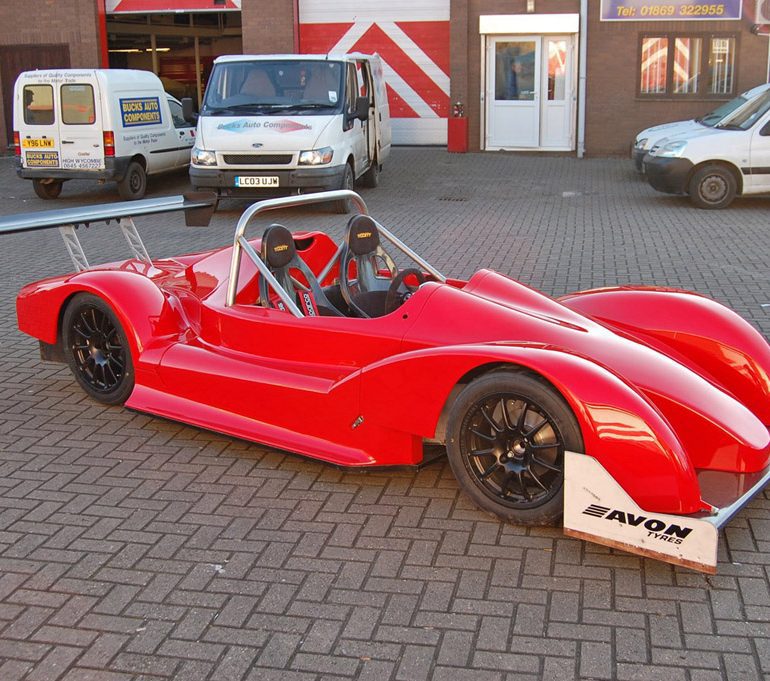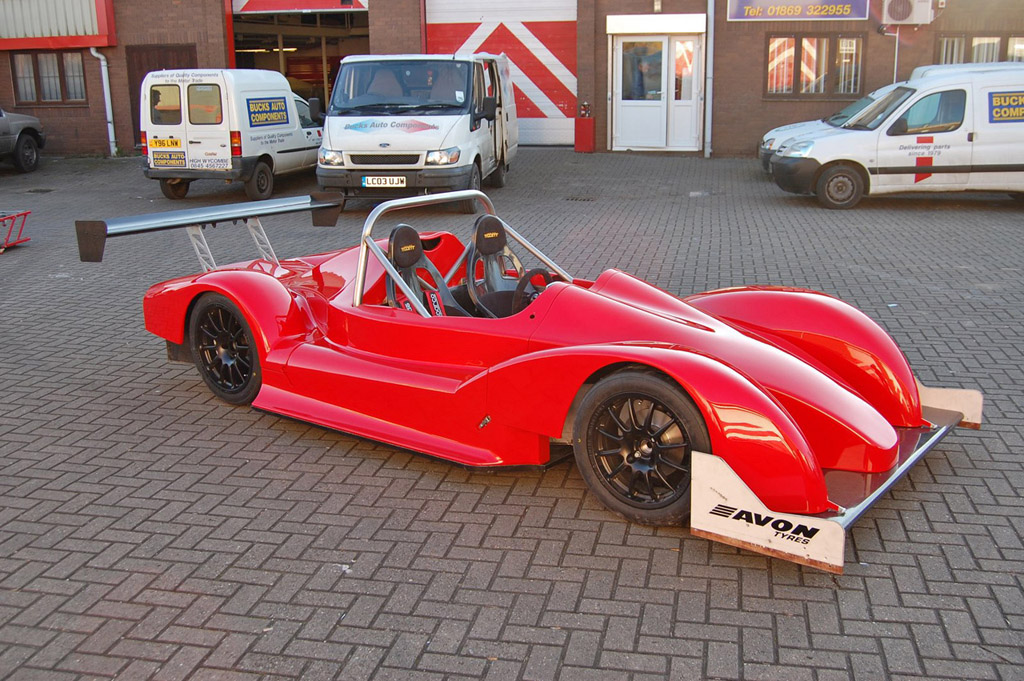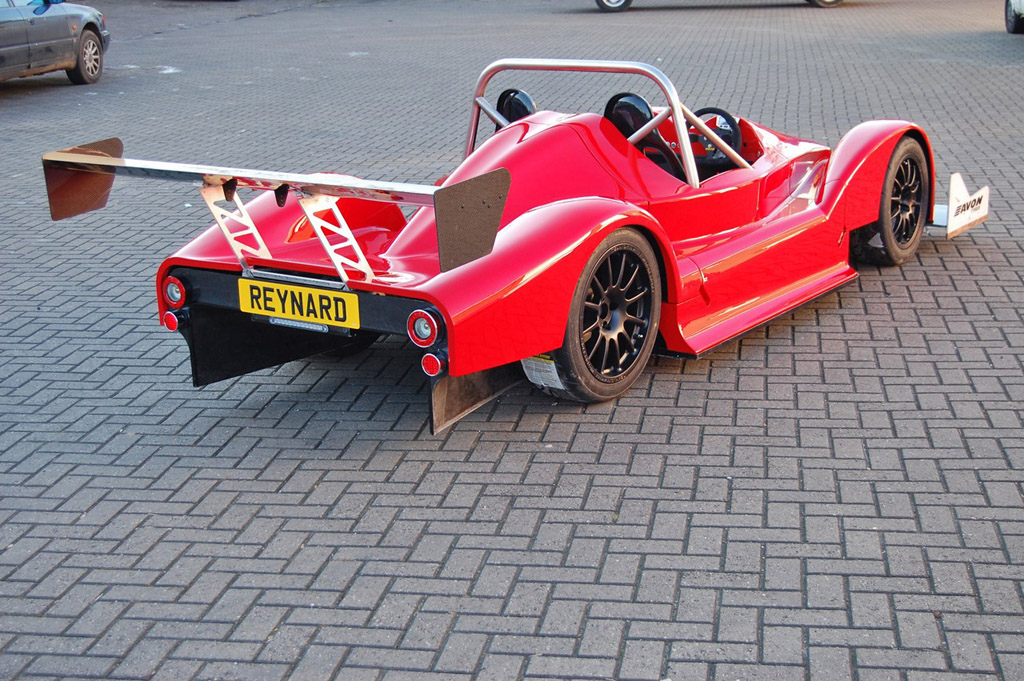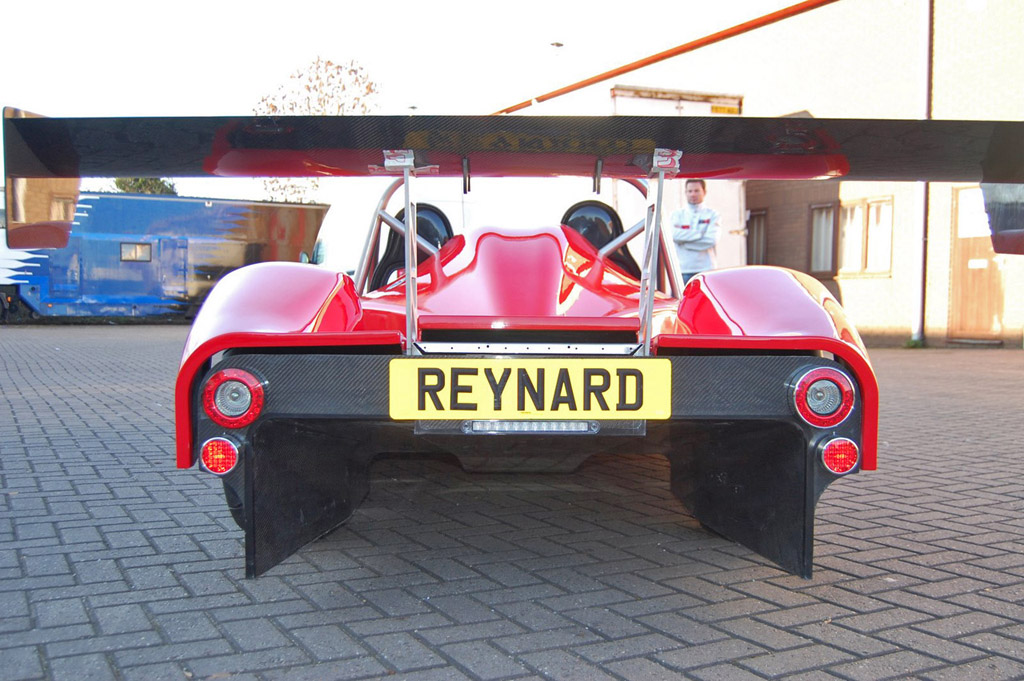2009 Reyard Inverter
A 2 seat sports car fully compliant with SVA regulations for low volume type approval and capable of being road registered. Designed to compete as a racing car in the 750 Motor Club Bike Sports Championship – this particular vehicle complies with Class C (standard Honda Fireblade engine up to 1000cc). Minimum weight with driver 475kg. The car weight including fluids but less driver is 400kg.
Track performance on Avon slicks will provide a 4G lateral cornering experience, until now unachievable outside the top echelons of high performance racing cars like F1. (8″X13″ front and 10″ X 13′ rear wheels) Road performance will provide excellent acceleration with 360 bhp/tonne power to weight ratio with the smallest standard Honda Fireblade engine or 530 bhp/tonne with the Hayabusa 250 bhp engine. For road use the car is equipped with treaded road legal tyres. (7″ X 16″ front and 9″ X 17″ rear wheels) Wind tunnel testing has proven that the car with driver can support twice it’s own weight at 100 mph and four times its own weight at terminal velocity. The car will drive upside down on a ceiling at 100 mph, hence the name Inverter.
Technical Description
The frame is constructed from laser cut, CNC bent and TIG welded stainless steel tube. Production versions may be robotically welded with MIG. The tubular frame is reinforced with two aluminium honeycomb composite side panels which are riveted into position to enhance torsion capabilities. These panels will be further reinforced by the addition of an outer lamination of Tegris which provides enhanced side- intrusion protection.
The nosebox has been designed in aluminium honeycomb, with the added feature of frontal side protection. This type of composite side protection panel and front crash-box concepts have been tested by Cranfield University and demonstrated excellent energy dissipation properties.
The final drive is accomplished by composite tooth belt. This feature requires no chain lubrication and eliminates the dispersion of grease and oil debris. Reverse gear is applied by 12v electric motor and applied via a simple sprag clutch. Differential is Quaife grease filled unit with production CV joints and driveshafts.
Paddle shift will augment the six speed sequential gearbox. This will enable flat-upshifting and auto-blip downshifting.
The uprights are all non-handed and water-jet cut from standard width aluminium plate. Minimal machining is required. All suspension wishbones are similarly non-handed. The front and rear body panels are designed so they can hinge to facilitate easy access. They can be moulded in GRP or carbon fibre to customer choice.
The Company
Reynard Racing Cars Ltd was founded in May 1974 by Adrian Reynard and Bill Stone, initially called Sabre Automotive Ltd. Adrian was a 23 years old graduate in Mechanical Engineering from Oxford Polytechnic (now Oxford Brookes University). Bill Stone was a successful racing driver from New Zealand and at the time, Production Manager at the recently formed March Engineering Ltd.
Adrian and Bill built the first Reynard racing cars in 1973 and first raced his Reynard 74FF at Silverstone in a 750 MC event. Adrian won its first race, which set a precedent for every subsequent marque.
Reynard Racing Cars eventually became the world’s largest race car manufacturer with a sequence of wins in FF2000, F3, F 3000, F Atlantic, Touring Car, Le Mans, IndyCar including two wins in the Indy 500 and Champcar.
In today’s market, Adrian realises it is vital to analyze the core competencies of a racing car company and distil these into efficient and harmonious working practices. Adrian identified these core activities as design, development and supply chain management.
Adrian Reynard met Andre Brown on an M.I.A. Mission to the Middle East in 2004. Both were interested in race car design, innovation, development and production. Andre was equipped with an excellent Engineering Degree from Bath University and had founded his own company Hartham, to undertake race car design and development.
Andre spent 18 months in Indianapolis during which time he participated in engineering design and wind tunnel development whilst also promoting technical sales at the Auto Research Center, Indianapolis.
Adrian contemplated two theories: ways to manufacture at much lower cost and Adrian had never made a road car. Adrian had also been influenced by building a Caterham Seven which he drove at BRDC Track Day events at Silverstone. With his lifetime experience of the industry, Adrian realised that the 750MC was still actively promoting various low cost formulae. For further reconnaissance, Adrian purchased an old Fisher Fury with a Honda motorcycle engine and enjoyed the 12,000 rpm track and road experience.
At the end of 2007, a new Reynard sports car was conceived to meet the 750MC Bikesports Championship regulations and would be the first ever Reynard car registered for road use. The car was to be smallest in class at 1.5m wide, simple, light, and easy to make by automated/CNC/robotic techniques.
Aerodynamics are relatively free in Bike Sports formula, so it was particularly attractive for Adrian and Andre to use the knowledge learned in Indy. Andre built a 50% scale model and this was evaluated during ‘downtime’ at the ARC wind tunnel facility.
The shape and form of the car evolved. The car was developed for high efficiency, so it was natural that the cross sectional area tapered toward the rear. The car also featured a shaped underbody that produced ‘ground effect’ down force but with little drag induced.
A design office was donated at the Honda F1 facility and the concepts were turned into CAD. Over the months Andre and Adrian forged the design parameters into real engineering drawings. Manufacturability was a common denominator. Keeping cost under control was a constant reminder.
Andre produced the final body surfaces derived from the wind tunnel model and these were routed by a full size CNC machining centre to produce the bodywork buck. The chassis and suspension parts were fabricated by Brady Fabrications of Bicester.
The car was realised during the first week of January 2009, nearly a year after work was commenced on the project. It has been an important goal to keep the ‘sunk costs’ to a minimum. Many car “projects” have unrealistic expectations with over optimistic manufacturing costs and sales forecasts.
The production of the Reynard Inverter will provide the car for the members of the 750 Motor Club, motor sport and Track Day participants who want an extraordinary road car experience.
The advanced and unique aerodynamic characteristics will allow the car to achieve unbelievable cornering abilities. On track tyres the driver will be able to experience up to 4G lateral acceleration – this is on the same level as F1.
The car is projected to attain 150 mph, and at that speed it produces down force levels that are four times its own weight.
This would theoretically allow the car to drive upside down at 100 mph, hence the Inverter model name.
The engine presently installed is the Honda Fireblade 998 cc unit that will rev to 14,000 rpm and produces 175 bhp. Other motorcycle engines are available, including the Suzuki Hayabusa. Car engine variants are also possible with some redesign of the rear frame.







